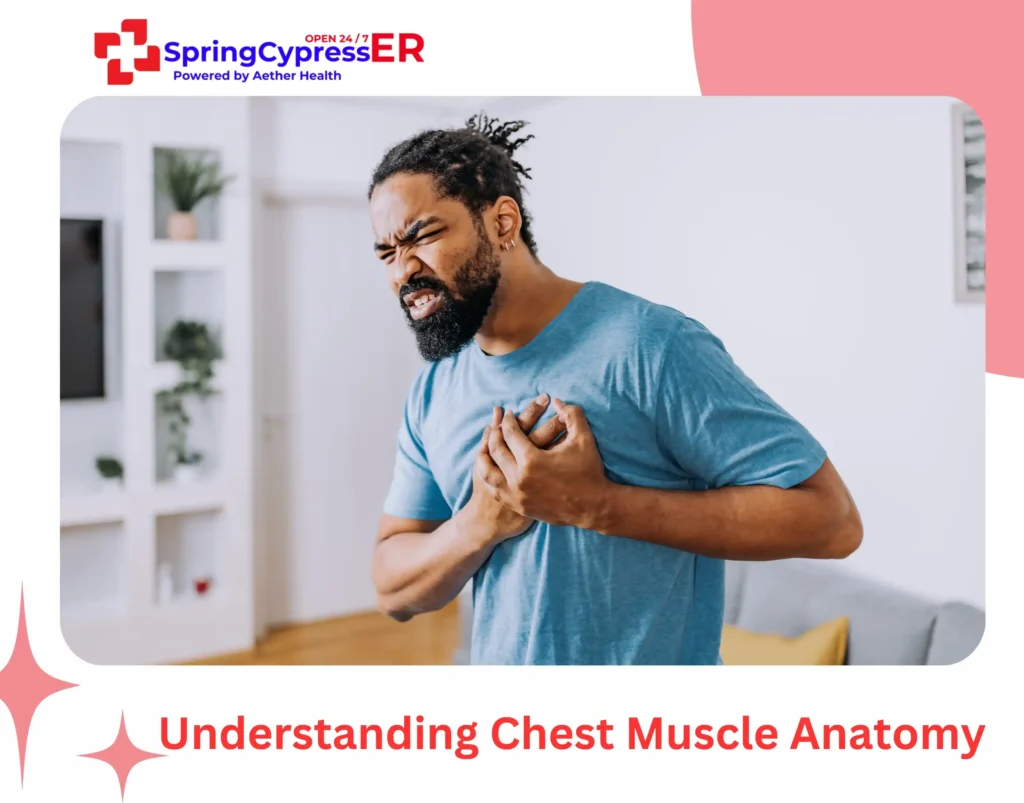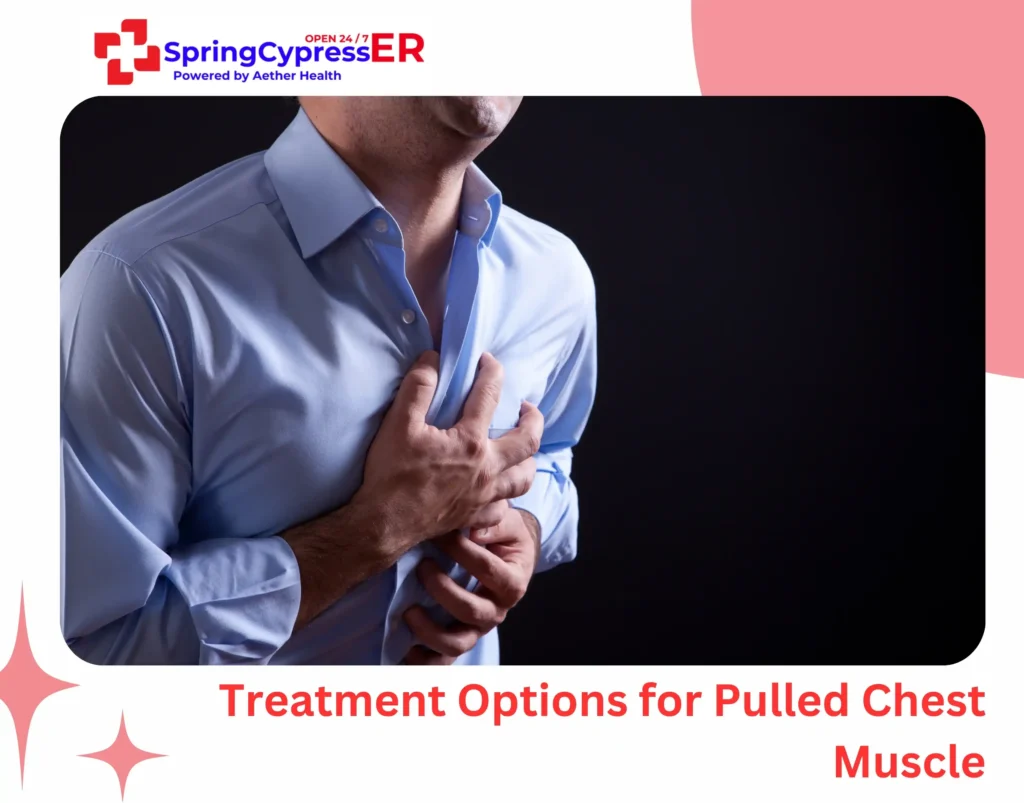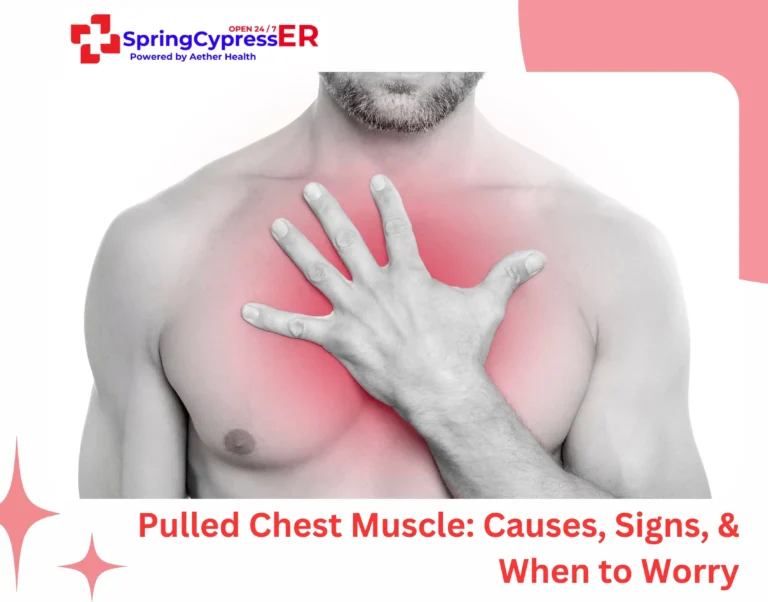A pulled chest muscle occurs when muscle fibers stretch beyond their normal capacity or tear completely. This injury creates inflammation, sharp pain, and muscle spasms that can feel identical to a heart attack.
According to Harvard Medical School, approximately 80% of chest pain cases are not cardiac-related¹. However, distinguishing between muscle strain and life-threatening heart condition requires immediate professional evaluation at a medical facility.
Understanding Chest Muscle Anatomy

Three muscle groups cause most chest muscle strain injuries. When any of these muscles become injured, the pain can feel surprisingly similar to heart problems.
● The Pectoralis Major
The pectoralis major are large muscles that stretch from your armpits to your breastbone. They control how you move your arms across your chest and rotate your shoulders. Most people recognize these as the main “chest muscles” that become prominent with exercise. Pectoralis major strains typically happen during weightlifting, especially bench pressing.
● The Pectoralis Minor
Positioned underneath the larger pectoralis major, these smaller muscles run along your upper ribs. They help stabilize your shoulder blades when you move your arms. Injuries here often develop from overhead activities or prolonged hunched postures.
● The Intercostal Muscles
Eleven pairs of muscles run between your ribs, forming your chest wall structure. These muscles contract and relax with every breath you take. Intercostal muscle strains account for nearly 50% of all chest muscle injuries and feel most frightening because they directly affect breathing comfort.
Why Pulled Chest Muscle Pain Feels So Alarming
The location near your heart explains why muscular chest pain feels like a cardiac emergency. Even mild muscle strains can cause breathing difficulties.
This combination of sharp chest pain and breathing issues triggers natural fear responses. The reaction is completely normal and understandable.
Some patients develop what physicians call chest wall syndrome; a pattern of chronic pain and anxiety following initial muscle injury.
Pulled Chest Muscle Symptoms
Pulled chest muscle symptoms develop immediately after injury or gradually over several hours. The pain location and characteristics help identify which muscle group is affected and determine the severity of your strain.
Common Pulled Chest Muscle Symptoms
Most chest muscle strains share these key characteristics:
- Sharp, stabbing pain that worsens with movement
- Localized tenderness you can pinpoint with one finger
- Muscle tightness or knot-like sensation under the skin
- Pain that increases with deep breathing, coughing, or sneezing
- Difficulty moving your arm in certain directions
- Muscle spasms that come and go throughout the day
How Symptoms Vary by Muscle Location
Pectoralis Major Symptoms:
- Pain across the front of your chest near the armpit
- Worsens when moving your arm across your body
- Tender to touch along the muscle edge
Intercostal Muscle Symptoms:
- Sharp pain between your ribs
- Breathing becomes uncomfortable or painful
- Pain wraps around from front to back along the rib
Pectoralis Minor Symptoms:
- Deep aching under the main chest muscle
- Pain when reaching overhead
- Shoulder blade discomfort
When Symptoms Get Better or Worse
Symptoms improve with:
- Rest and avoiding aggravating movements
- Ice application during the first 48 hours
- Anti-inflammatory medication
- Gentle position changes
Symptoms worsen with:
- Continued activity or exercise
- Deep breathing or forceful coughing
- Lifting objects or reaching overhead
- Sleeping in awkward positions
Chest Muscle Strain Severity Levels
Emergency physicians classify muscle strains using three grades that help determine the severity of your condition. Each grade presents distinct characteristics and requires different treatment approaches.
Grade 1: Mild Strains
- Muscle damage: Less than 5% of muscle fibers affected
- Pain characteristics: Sharp, localized pain that worsens with movement but allows most daily activities
- Recovery time: 2-3 weeks with conservative treatment
- Key indicator: You can pinpoint the exact pain location
Grade 2: Moderate Strains
- Muscle damage: Significant fiber damage with partial muscle tear
- Pain characteristics: Moderate to severe pain with noticeable chest muscle spasms affecting daily activities
- Recovery time: 4-8 weeks requiring structured rehabilitation
- Key indicator: Visible swelling and difficulty with arm movements
Grade 3: Severe Strains
- Muscle damage: Full muscle separation or tendon detachment
- Pain characteristics: Severe, constant pain even at rest with extreme breathing difficulty
- Recovery time: 8-16 weeks, may require surgical intervention
- Key indicator: Visible deformity and inability to use affected arm normally
Chest Muscle Strain vs Heart Attack: Critical Differences
Chest strains and heart attacks have distinctive symptoms, though professional evaluation is essential for definitive diagnosis.
Muscle Strain Warning Signs
- Pain worsens with specific movements or positions
- Tenderness when touching the affected area
- Pain typically stays localized to one area
- Symptoms improve with rest and anti-inflammatory medication
- No accompanying sweating, nausea, or dizziness
Heart Attack Symptoms
- Pain often described as pressure, squeezing, or crushing
- Pain radiates to arms, jaw, neck, or back
- Accompanied by sweating, nausea, shortness of breath
- Pain doesn’t improve with position changes
- May include rapid or irregular heartbeat
Critical Point: Muscle strain and heart attack symptoms can overlap, and multiple conditions can occur simultaneously. Age, fitness level, and previous health history don’t guarantee safety from cardiac events.
What Causes Pulled Chest Muscle Strains?
Most pulled chest muscle strains result from activities that place sudden or excessive stress on these muscle groups. Understanding common causes helps you recognize injury patterns and take preventive measures.
Sports and Exercise Injuries
Athletic activities create the highest risk for pulled chest muscle strains. High-risk activities include:
- Tennis and racquet sports: sudden reaching motions
- Golf: rotational swing mechanics
- Weightlifting: particularly bench pressing and overhead exercises
- Swimming: repetitive overhead stroke patterns
- Contact sports: direct trauma to chest muscles
Occupational and Daily Activities
Many pulled chest muscle strains occur during routine activities when muscles aren’t prepared for sudden stress.
- Common workplace injuries happen during heavy lifting, repetitive overhead reaching, and sudden twisting while carrying objects.
- Household activities like moving furniture, lifting boxes from shelves, or yard work frequently cause unexpected muscle strains.
Medical Causes:
- Persistent coughing from respiratory infections
- Post-COVID complications
- Bronchitis or bad colds
- Certain medication side effects
Lifestyle Factors:
- Poor posture from desk work
- Repetitive motions in manual labor
- Sudden movements during daily activities
- Returning to exercise after periods of inactivity
Pulled Chest Muscle in Women: Location-Specific Symptoms

Women experience chest muscle strains differently than men due to their body structure and daily activities. Understanding these pain patterns determines whether it’s a muscle problem or a heart issue.
Pulled Chest Muscle Female Left Side
Pulled chest muscle on left side in females typically involves the pectoralis major or intercostal muscles. These strains develop from poor sleeping positions with inadequate pillow support, sudden movements during exercise (especially yoga or pilates), and repetitive cross-body movements that stress the non-dominant side.
Workplace ergonomics and heavy lifting with rotation or awkward positioning also create left-side vulnerability. Additional causes include carrying children on the left hip while performing tasks with the dominant right arm.
Left-side chest muscle strain triggers concern because the pain sits close to the heart. This fear makes perfect sense and shouldn’t be ignored.
Left-side muscle strain symptoms in female include:
- Sharp pain that worsens with cross-body arm movements
- Tenderness around the left breast area that increases with pressure
- Pain increases when you breathe deeply or cough
- Discomfort when wearing restrictive clothing or supportive bras
Pulled Chest Muscle Female Right Side
Right-sided chest muscle strains happen more often because most women are right-handed and overuse their dominant side. Common causes include reaching overhead repeatedly while cleaning, lifting heavy objects throughout the day, and carrying heavy purses on your right shoulder.
Right-side chest strain symptoms include:
- Pain concentrated around the right pectoral area
- Increased discomfort during dominant arm activities
- Progressive worsening throughout active days
- Sharp tenderness when pressing directly on the affected muscle
Easy way to identify: Think about your recent activities. Did the pain start after cleaning house, moving furniture, or exercising more than usual? This points to muscle strain.
However, women can experience atypical heart attack symptoms that overlap with muscle strain signs. When you’re not sure, get checked out. It’s better to have a doctor confirm it’s just a muscle strain than to ignore something serious.
Emergency Warning Signs: When to Seek Immediate Care
Certain symptoms should never be ignored, regardless of whether you suspect a muscle strain. These warning signs indicate potentially life-threatening conditions that require immediate medical attention.
Red Flag Symptoms that Need ER Visit
Seek emergency care immediately if chest pain includes:
- Sweating, nausea, or dizziness
- Pain radiating to arms, jaw, neck, or back
- Pressure, squeezing, or crushing sensation
- Shortness of breath
- Rapid or irregular heartbeat
- Loss of consciousness or near-fainting
Why Age Doesn’t Guarantee Safety
Young adults often assume they’re immune to heart problems. This thinking can be dangerous.
Emergency departments regularly treat cardiac events in people under 30. Stress, substance use, genetics, and underlying conditions affect all age groups.
Family history significantly impacts risk, even in young adults. Don’t let age create false security about chest pain.
Understanding the “Pressure Test” Limitation
Some people try pressing on chest muscles to self-diagnose. While muscle pain may worsen with pressure, this test cannot reliably rule out heart problems.
Multiple conditions can occur simultaneously. Professional evaluation remains essential regardless of any self-assessment results.
Treatment Options for Pulled Chest Muscle

When experiencing chest pain, your first priority should be determining whether emergency care is needed rather than attempting self-diagnosis. However, for confirmed muscle strains under medical guidance, several treatment approaches can provide significant relief.
RICE Method for Confirmed Pulled Chest Muscle Strains
- Rest: Stop activities that worsen pain. Avoid upper body exercises and heavy lifting.
- Ice: Apply ice packs for 15-20 minutes, several times daily. Wrap in cloth to prevent skin damage.
- Compression: Use gentle elastic bandaging. Ensure it’s not too tight to impair breathing.
- Elevation: Keep chest elevated, especially while sleeping. Try sleeping in a recliner or use extra pillows.
Safe Pain Management Options
- Ibuprofen or other NSAIDs for pain and inflammation
- Acetaminophen for pain relief
- Always consult a healthcare provider about medication interactions
Position Modifications for Comfort
- Avoid positions that stretch affected muscles
- Experiment with different sleeping arrangements
- Try sitting upright if lying down worsens pain
What You Should Never Do
- Never attempt definitive self-diagnosis between muscle strain and cardiac issues
- Don’t dismiss symptoms based on age or fitness level
- Avoid pushing through severe pain that interferes with breathing
- Don’t delay seeking care if genuinely worried about symptoms
How Emergency Room Handles Pulled Chest Muscle Cases
The Spring Cypress emergency room provides immediate chest pain assessment using advanced diagnostic technology and experienced emergency physicians. Our facility combines hospital-level care with shorter wait times and focused attention.
Rapid Professional Evaluation
The evaluation process begins immediately upon arrival with rapid triage and prompt assessment by board-certified emergency physicians. You’ll typically receive an EKG within minutes, followed by detailed medical history and physical examination tailored to your specific symptoms and risk factors.
Advanced Diagnostic Capabilities
Immediate Testing Available:
- EKG within minutes of arrival
- Digital X-ray systems for instant imaging
- CT scanning for detailed chest evaluation
- Clinical laboratory testing for cardiac markers
Professional Assessment Process:
- Detailed medical history and symptom evaluation
- Physical examination by experienced emergency team
- Risk stratification based on symptoms and medical background
Emergency physicians regularly evaluate conditions including intercostal neuralgia and costochondral junction pain, ensuring thorough assessment of all potential chest pain causes.
Never Ignore Chest Pain
Pulled chest muscle strains can create genuine terror due to their location and intensity, but medical assessment provides both accurate diagnosis and peace of mind. While most chest pain is not cardiac-related, the overlapping symptoms between muscle strains and serious conditions make professional evaluation essential.
If you’re experiencing chest pain and need immediate evaluation, Spring Cypress ER is available 24/7. Our emergency physicians provide rapid assessment to address your concerns and ensure appropriate care.
Frequently Asked Questions
1. Should I worry about chest pain that comes and goes?
Yes. Intermittent chest pain still requires professional evaluation. Both muscle strains and serious cardiac conditions can cause on-and-off pain patterns.
2. Can young people have heart problems?
Absolutely. While less common, heart problems affect people of all ages. Age alone doesn’t provide protection from cardiac events.
3. How quickly should I seek care for chest pain?
For symptoms suggesting cardiac issues (pressure, radiating pain, sweating), seek Immediate Emergency Care For other concerning chest pain symptoms, professional evaluation within hours is appropriate. Trust your instincts about symptom severity.
4. What should I expect during my ER visit?
Expect immediate triage and rapid evaluation. You’ll likely receive an EKG within minutes, followed by medical history and physical examination. Additional testing depends on your symptoms and risk factors.
5. How long does a pulled chest muscle take to heal?
Most pulled chest muscles heal within 2-3 weeks for mild strains, 4-8 weeks for moderate strains, and 8-16 weeks for severe tears. Healing time depends on the severity of injury, your age, and how well you follow treatment recommendations.
6. Is heat or ice better for a pulled chest muscle?
Ice is typically better for acute injuries. Apply ice packs several times daily for the first 3 days to reduce inflammation and pain. After the initial swelling goes down, you can switch to heat therapy to relax tight muscles and improve blood flow. Never apply ice or heat directly to skin.




